The Drill Down, Issue #23: Hazardous Location Electrical Markings - Applicable Standards
 Introduction
Introduction
This edition of the Drill Down begins a multi-part series on the interpretation of markings for electrical equipment installed in a Hazardous Location or Hazardous Area, abbreviated in this series as HazLoc. This analysis is intended to help personnel understand electrical equipment markings to verify that the equipment is safe for the areas in which it is installed. Figure 1 is an example label that will be used throughout this HazLoc electrical markings series.
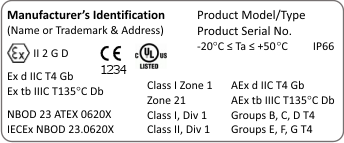 |
| Figure 1: Example HazLoc electrical equipment label |
This Drill Down will focus on the standards that are utilized for HazLoc electrical equipment compliance for vessels or OCS facilities subject to U.S. Coast Guard (USCG) regulatory requirements.
Standards for Compliance prior to April 17, 2023
U.S. vessels, other than offshore supply vessels (OSVs) regulated under 46 CFR Subchapter L, built on or before April 2, 2018, follow the regulations found in 46 CFR 111.105.
U.S. and foreign mobile offshore drilling units (MODUs), floating OCS facilities (FOFs) and vessels conducting OCS activities built after April 2, 2018, must follow the regulations found in 46 CFR 111.108. U.S. MODUs, FOFs, vessels other than Subchapter L OSVs and U.S. tank vessels may comply with §111.108 in lieu of specific sections of §111.105.
OSVs built on or before August 18, 2014, must follow the regulations found in 46 CFR 111.105 in accordance with (IAW) §129.520. OSVs of less than 6,000 GT ITC or 500 GRT built after August 18, 2014, must follow the regulations in §111.105 IAW §129.110(b), while OSVs 6,000 GT ITC or 500 GRT and larger built after August 18, 2014, must follow the regulations at §111.106 IAW §129.110(a).
These regulations have standards that are incorporated by reference (IBR), each with its own marking system or “scheme” for HazLoc electrical equipment.
Units[1] or vessels required to follow the IBRs found in 46 CFR 111.105-1 have three marking systems:
1) A national marking system found in National Fire Protection Association (NFPA) 70 (National Electric Code (NEC)), ninth edition (2002), Article 500 (encompassing electrical protection methods of Articles 500 through 504);
2) A national marking system found in NFPA 70 (2002), Article 505 that closely resembles the international marking system; and
3) The “international marking system” found in International Electrotechnical Commission (IEC) 60079-0, 3.1 edition (June 2001).
Units or vessels required to comply with 46 CFR 111.106-3 or §111.108-3[2] can follow the standards of NFPA 70 (2011 Edition), Articles 500 or 505, or IEC 60079-0 (via additional IEC standards referenced as IBRs, e.g. IEC 60092-502, 61892-7). Other than the IBR edition, the marking systems are the same as the §111.105-1 IBRs.
Standards for Compliance on or after April 17, 2023
The USCG published a final rule via 88 FR 16310 on March 16, 2023 that updated the aforementioned IBRs. The referenced standards mostly remained the same but were updated to a more recent edition of the standard, although not necessarily the current edition. Units built on or after April 17, 2023, must comply with the updated editions of the IBRs.
Under this rulemaking, NFPA 70 was updated to the 2017 Edition for the previously cited regulations. The IEC 60079-series vary in edition with the specific part (e.g. 60079-1, 60079-7), spanning 2011 to 2017 in editions. The reference to IEC 60079-0 was removed, but it is utilized as a “normative reference” within each IEC 60079 part that is an IBR and is therefore, still applicable. Normative references in IEC standards function like IBRs in CFRs.
We will utilize the updated IBRs, and cite them accordingly, throughout this HazLoc electrical markings series. It is important to note that installed equipment may be built to, and be marked in accordance with, newer editions of the standards than those cited as IBRs.
See the appendix to this Drill Down (at the bottom of this page) for a reference chart that summarizes the regulatory cites, applicable standards and implementation dates previously discussed.
When is ATEX Equipment Acceptable?
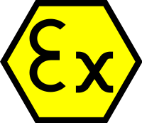 |
Figure 2:
ATEX Symbol |
ATEX equipment will often be encountered when inspecting HazLoc equipment and denoted by the presence of the ATEX symbol (figure 2) and associated ATEX markings. “ATEX” is derived from the first two letters of the French words “atmosphères explosibles” that translate into “explosive atmospheres” and is a European Union directive addressing the same. The USCG has stated that ATEX equipment will not be accepted[3]. This is due to the provision that allows manufacturers to self-certify certain equipment for hazardous areas under the ATEX directive, while the USCG requires HazLoc equipment to be certified by an independent, third party.
There are cases where ATEX equipment may be used, such as when the equipment is tested and certified to the applicable standards contained within 46 CFR Subchapter J by an independent laboratory that is accepted by the USCG (e.g. UL). In this case, the equipment is not accepted as ATEX equipment, but because it meets other required standards. Additional HazLoc equipment markings will be present on the equipment to show compliance with U.S. and/or IEC requirements.
U.S. Coast Guard Accepted Labs
USCG accepted laboratories (third party) can be verified through the USCG Maritime Information Exchange (CGMIX) webpage at https://cgmix.uscg.mil/. Locate the accepted labs search page via the menu path of “Search CGMIX > USCG Accepted Laboratories > Accepted Labs Search” (figure 3) and conduct a search for “Hazardous Locations (111.105/106/108)” from the accepted laboratories search page (figure 4).
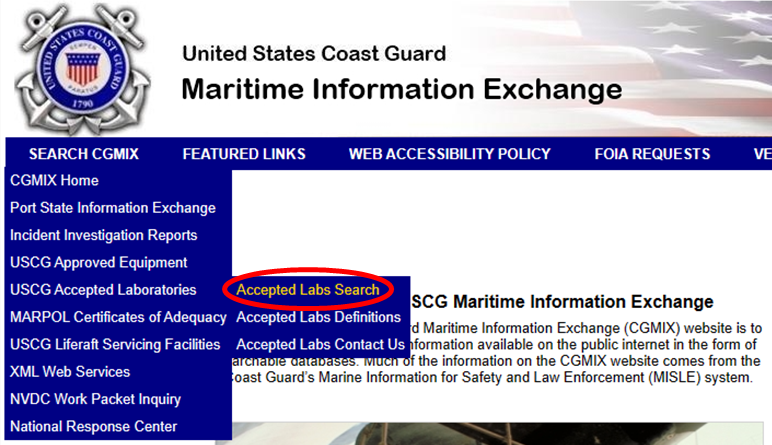 |
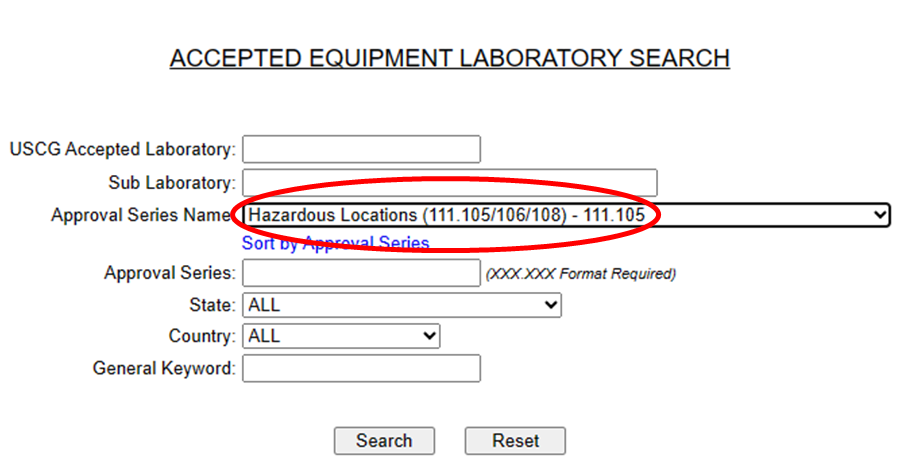 |
| Figure 3: CGMIX accepted labs search location |
Figure 4: CGMIX accepted labs search page |
The Drill Down is also dependent on you! Contact us if you’d like a specific topic covered in more detail, or if you find an issue on an inspection or examination that you think needs to be shared with the OCS community. Expect new issues regularly where we will continue to explore these fields in the Drill Down.
The numerous compliance standards, protection methodology and associated markings incorporated for electrical equipment installed in hazardous locations result in a complicated subject. While the revised editions of the incorporated standards may be similar to earlier editions, there are differences, so it is important to ensure that the correct edition is being referenced when inspecting or examining HazLoc equipment for compliance on a particular unit or vessel.
Subsequent editions of this Drill Down series will examine individual components that comprise HazLoc electrical equipment markings. The following topics are included in this series:
The marking requirements of NFPA 70, Articles 500 and 505 and IEC 60079-0 will be reviewed as they relate to each topic.
Note: This HazLoc markings series does not attempt to instill competence to an individual but has the intended purpose of bringing awareness of the applicable standards incorporated through U.S. Coast Guard regulations and to what is indicated by each component of HazLoc electrical equipment markings.
The term “unit” in this Drill Down includes OCS facilities and vessels as the term is defined at 33 CFR 140.10.
NFPA 496 compliant electrical equip used as an alternative to NFPA 70, Articles 500-504 doesn’t require independent lab marking (§111.108-3(d)).
See discussion in the March 31, 2015 final rule published as 80 FR 16980.
A pdf of the reference table displayed below can be accessed at HazLoc Standards Reference Table.
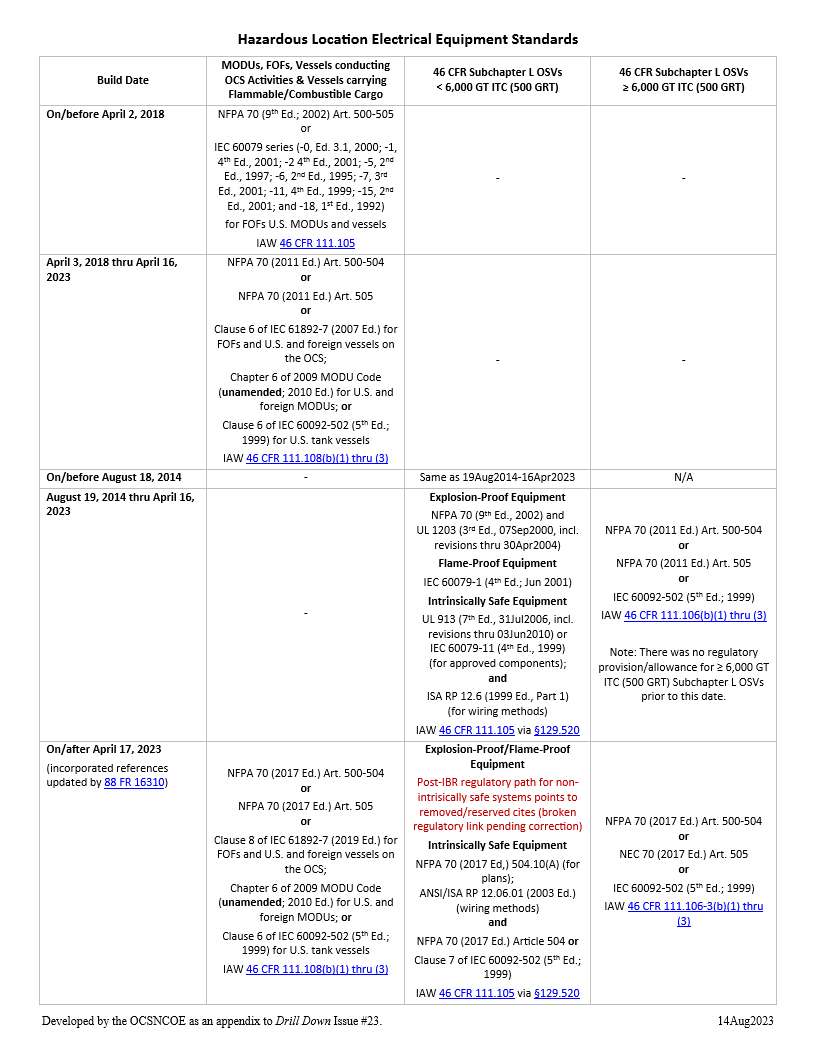
Published 14Aug2023.